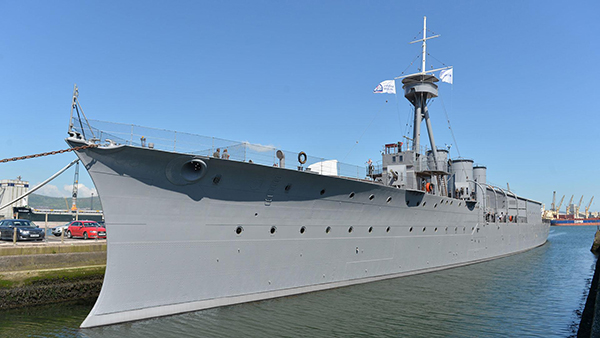BITE-SIZED HISTORY
Published in Issue 1 (January/February 2021), Volume 29BY TONY CANAVAN

Above: HMS Caroline, the last survivor of the 1916 Battle of Jutland, now a floating museum in Belfast’s Alexandra Dock. (visitBelfast)
Battle of Jutland survivor stays afloat
It was feared that ten jobs could go at the HMS Caroline floating museum in Belfast as the British government’s Coronavirus Job Retention Scheme ended, but the museum’s staff have been offered a temporary reprieve. The National Museum of the Royal Navy (NMRN) announced that it has come to a joint understanding with the NI Department for Economy, which means that it will continue to operate the ship until the end of the year. HMS Caroline is berthed in Alexandra Dock in the heart of Belfast’s Titanic Quarter and is the last survivor of the 1916 Battle of Jutland, the largest naval battle ever fought. Covid restrictions in Northern Ireland resulted in the museum’s closure and it was feared that it might close permanently, but the agreement between the NMRN and the Department for the Economy means that it is safe for the time being.
Adding colour to Old Ireland
Prof. John Breslin’s research into his own family tree led him to a number of black-and-white photographs. He began to add colour to these old photos and what started out as a pastime has become a major project, as Breslin has colourised a whole collection of photos of Ireland in the nineteenth and twentieth centuries, covering a range of domestic scenes and public events. The photos have all been given new life by having colour added to them and are brought together in a book, Old Ireland in colour (Merrion Press). The process of colourising photos does, however, raise some issues. The person who took the original photos conceived of them as being black and white; in other words, the composition and use of light was predicated on the end product being a monochrome photograph. Does adding colour to such a photograph not compromise its artistic integrity? Would anyone seek to ‘improve’ the drawings of Leonardo da Vinci, for example, by colouring them in?
Celebrating Northern Ireland?
Recently the British government set up a ‘forum’ to discuss plans to commemorate the centenary of Northern Ireland after Prime Minister Boris Johnson said that the creation of Northern Ireland was something to be celebrated. The twenty-member forum is chaired by Northern Ireland Office director of communications Andy Pike and consists entirely of unionists. Sinn Féin and the SDLP turned down an invitation to join, both parties stating that the centenary was not something to celebrate. Meanwhile, some local authorities in Northern Ireland have also declined to mark the centenary. Despite this, two Irish government civil servants have joined the forum as observers, along with Elizabeth Trudeau, the US consul general in Belfast. The Irish civil servants, who are understood to answer questions and give guidance, are not part of the Taoiseach’s Shared Island Unit. The Northern Ireland Office has said that the centenary will be marked ‘in a spirit of mutual respect, inclusiveness and reconciliation’. Given, however, that Northern Ireland was established by partitioning Ireland and given its troubled history, expecting Northern nationalists to take part in the celebrations is probably akin to asking non-white South Africans to celebrate the anniversary of Apartheid.
Belfast to honour Frederick Douglass
Belfast City Council has accepted a proposal to erect a statue of the anti-slavery activist Frederick Douglass on a site in the city centre. Sinn Féin members of the council made the proposal for the tribute to the American activist, author and public speaker. The statue will be in Rosemary Street, where Douglass addressed crowds on the suffering of African American slaves. On his life-changing Irish tour, Douglass spoke in Belfast, Waterford, Cork, Limerick and Wexford between October and December 1846. He shared a platform with Daniel O’Connell and said later that it was during his time in Ireland that he came to realise that ‘the cause of humanity is one the world over. He who really and truly feels for the American slave, cannot steel his heart to the woes of others.’ The project will now move to the design stage. Speaking about the idea, Sinn Féin’s Ciaran Beattie said: ‘This statue will not only be a tribute to Douglass, but also to the anti-racism movement in Belfast and across Ireland. From Belfast to the world, this is a clear and unambiguous message—Black Lives Matter.’
Ribbonmen and Silent Witness
British viewers of a recent edition of the BBC’s Who Do You Think You Are? got an unexpected Irish history lesson when Silent Witness actress Liz Carr’s search through her family tree brought her to Killeavey, Dromintee and Armagh. Here she discovered that her great-great-great-grandfather, Bernard ‘Barney’ Ryan, was involved in the attempted murder of a prominent landlord in County Armagh in the 1850s. Ryan was a leading figure in the Ribbonmen, a secret society of mainly Catholic tenants formed to take action against landlords and their agents. The landlord in question, Meredith Chambre, was shot multiple times but survived. Francis Berry, an associate of Barney Ryan, was executed in Armagh Gaol for the attempted murder of Chambre. Liz Carr said of the event: ‘I don’t approve of how far it went but I don’t feel ashamed of Barney. The reason the men involved were fighting for change and justice, I understood. It’s about vengeance against a greedy, malicious landowner. That radicalism sits comfortably with me.’
















